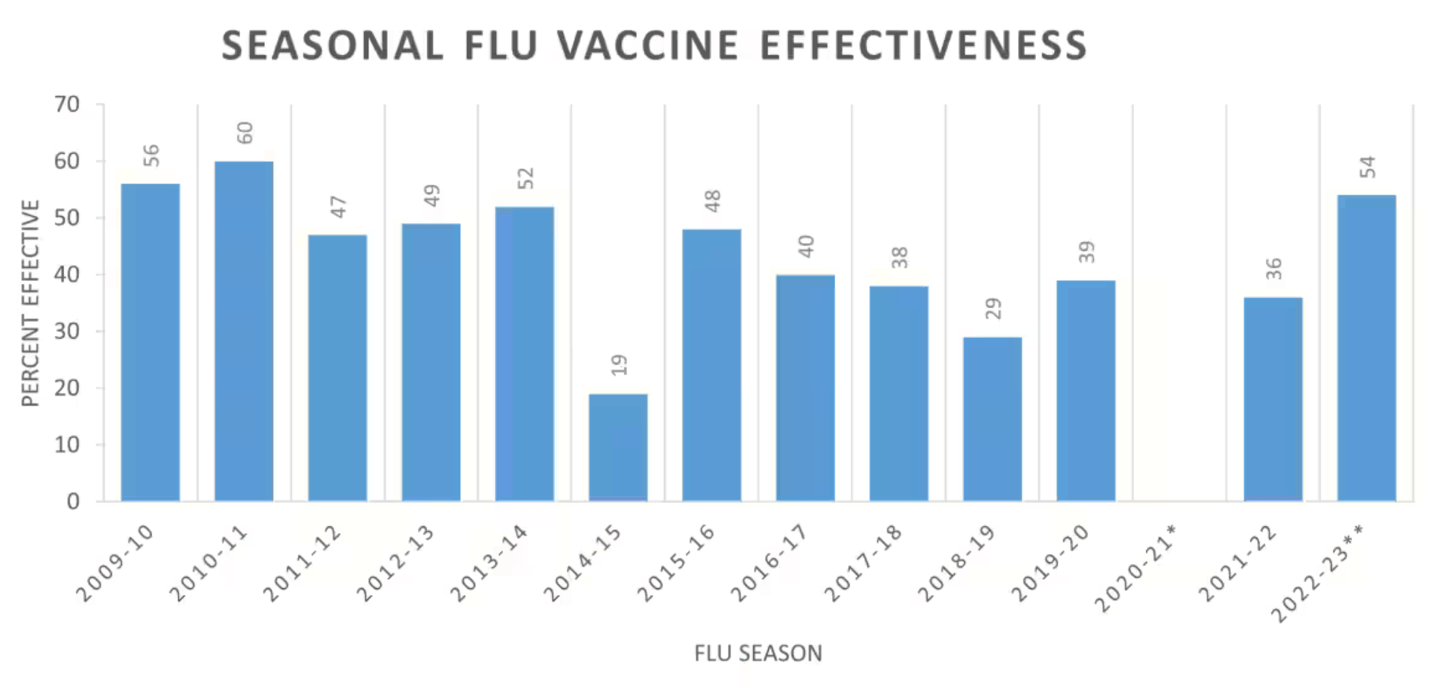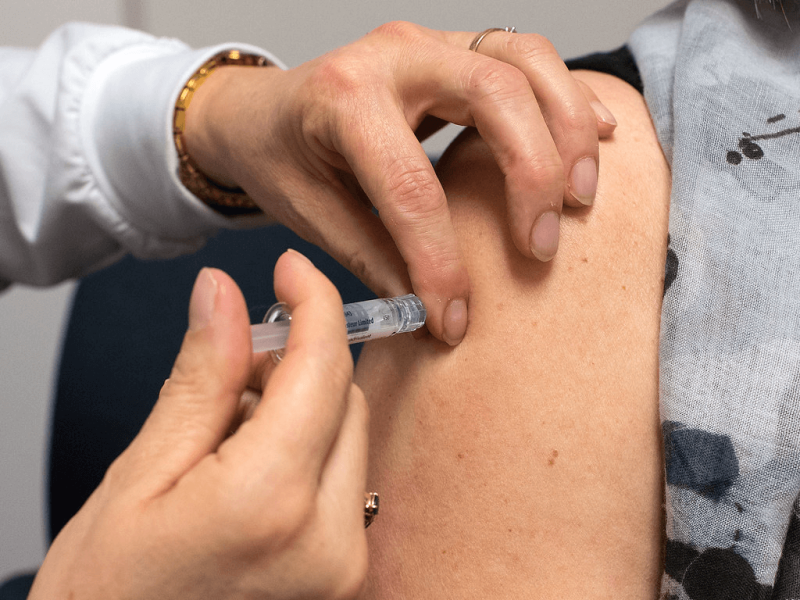It’s that time of year again. No, I am not referring to the latest COVID-19 vaccines, which are now available. And even if you’re skeptical about shots to prevent getting the coronavirus (which based on massive scientific evidence are incredibly effective with a very low chance of side effects), that’s no reason to forego getting an annual influenza shot.
On average, the United States experiences about 41 million flu-related illnesses annually. That’s more people than got COVID in any one year since the pandemic began. Over the past decade, influenza has killed as many as 650,000 globally in a single year, and from 12,000 to 52,000 people in the US. And unlike with COVID, the very young are among the most vulnerable.

How does the CDC pick and formulate which strains of the flu to target?
The process of selecting viruses for the yearly flu vaccines is complex and inexact. One major reason is that scientists need to make calculated guesses of which flu strains will be most prominent in which country many months in advance of the commencement of the autumn flu season. The promising news is that for the 2023-2024 flu season, there is reason to be optimistic that the vaccines will provide good protection.
Flu is the prototype of a respiratory disease that requires repeated — yearly — vaccinations to prevent infection; the effectiveness of the shot only lasts about six months. Although annual seasonal flu vaccines are invaluable tools for controlling the spread and severity of influenza, they do not provide immunity against every strain of the virus, which constantly mutates, sometimes radically.
Flu vaccines that would confer long-term immunity and eliminate the need for yearly shots to protect against new variants would be an important public health advance, but attempts to develop them have been unsuccessful. So, we are left with a complex process, described below, for formulating the vaccines for each flu season.
Seasonal flu vaccines are designed to protect against the four main groups of flu Type A and B viruses that experts believe are most likely to spread and cause illness during the upcoming flu season. Current U.S. flu vaccines protect against two forms of both influenza A and B. The vaccines’ components are selected anew each year based on:
- which flu viruses are causing illnesses prior to the upcoming flu season,
- the extent to which those viruses are spreading before the upcoming flu season,
- how well the previous season’s vaccines may protect against those flu viruses,
- the ability of vaccine viruses to provide cross-protection against a range of related flu viruses of the same type.
This excerpt from the CDC’s document, “Selecting Viruses for the Seasonal Influenza Vaccine,” describes the process for formulating the flu vaccines:
There are currently 144 national influenza centers in over 114 countries that conduct year-round surveillance for flu viruses as part of the World Health Organization (WHO) Global Influenza Surveillance and Response System (GISRS). This involves receiving and testing thousands of flu virus samples from patients. …
Twice a year, the WHO organizes a consultation with the directors of the seven WHO Collaborating Centers, Essential Regulatory Laboratories, and representatives of key national laboratories and academies. After reviewing the results of surveillance, laboratory, and clinical studies, and the availability of flu vaccine viruses, they make recommendations on the composition of flu vaccines.
These meetings take place in February for selection of the upcoming Northern Hemisphere’s seasonal flu vaccines and in September for the Southern Hemisphere’s flu vaccines. …Next, each country makes its own decision about which viruses should be included in flu vaccines licensed in their country.
In the United States, the FDA’s Vaccines and Related Biological Products Advisory Committee (VRBPAC) makes the final decision about vaccine viruses for domestic flu vaccines.
Beginning in late winter, the various manufacturers of flu vaccines, using a variety of technologies, begin to produce them for the next flu season, seven or eight months away.
How reliable are flu vaccines?
Because of the changeable nature of flu variants, the somewhat inexact science involved in identifying all possible variants, the time lag in developing the billions of vaccine doses to distribute in each hemisphere, the influenza shot, like any protective virus jab, is not totally effective. It’s estimated that last year, flu shots reduced incidences in the U.S. by 54%.

How good will this year’s predictions about which viruses to include in the 2023-2024 vaccines for the North America be? Mid-season data from the Southern Hemisphere (where the fall-winter flu season precedes that in the Northern Hemisphere, and is just concluding) suggest the current season’s trivalent and quadrivalent inactivated flu vaccines protect quite well against the most serious outcomes, according to a September 15 report by CDC researchers:
The 2023 Southern Hemisphere seasonal influenza vaccine reduced the risk for influenza-associated hospitalizations by 52%. Circulating influenza viruses were genetically similar to those targeted by the 2023–24 Northern Hemisphere influenza vaccine formulation. This vaccine might offer similar protection if these viruses predominate during the coming Northern Hemisphere influenza season.
The language is measured, but the report offers presumptive good news about the currently available round of vaccines.
A significant and sobering finding in the CDC report was that less than a quarter of the hospitalized patients had been vaccinated. At least part of the explanation in recent years was the flood of misinformation around the safety of the COVID-19 vaccine. A University of California-Los Angeles study found a 4.5% drop off in states with below average pandemic vaccination rates. That drop-off was slightly offset by a modest surge in flu vaccine rates in states with strong uptake of the coronavirus vaccine. Flu vaccination rates ranges from 50% in Alabama to 81% in Rhode Island. On average, around the world, only about 25% of people get an annual influenza shot.
“This supports what I have seen in my clinical practice and suggests that information and policies specific to Covid-19 vaccines may be eroding more general faith in medicine and our government’s role in public health,” said the study’s lead author, Richard Leuchter, MD, a resident physician at UCLA Health.
To counter the dismal numbers, the CDC now recommends: “Health authorities worldwide should encourage influenza vaccination for persons at increased risk for severe disease, including young children, persons with preexisting health conditions, and older adults, as well as those at increased risk for exposure to or transmission of influenza virus, such as health care personnel.”
In the end, it is not vaccines that prevent infections; it is vaccinations.
Henry I. Miller, a physician and molecular biologist, is the Glenn Swogger Distinguished Fellow at the American Council on Science and Health. He was the founding director of the FDA’s Office of Biotechnology. Find him on X @henryimiller































